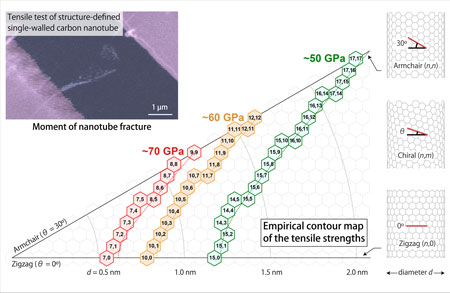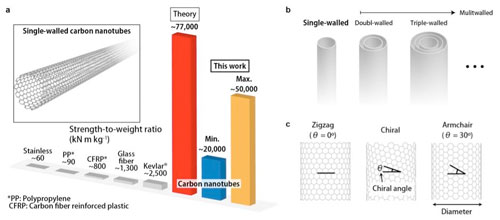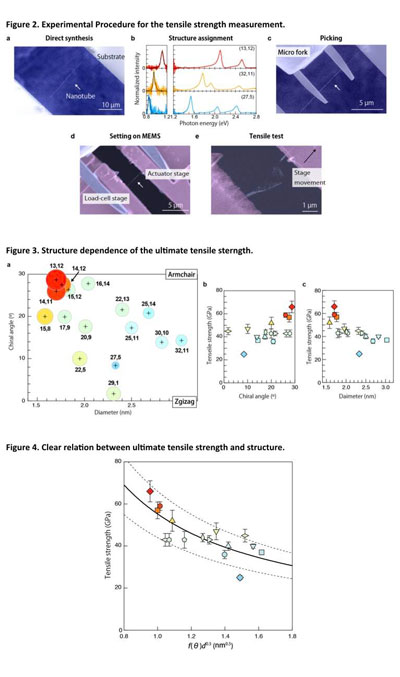| Sep 18, 2019 | |
Tensile strength of carbon nanotubes depends on their chiral structures(Nanowerk News) Single-walled carbon nanotubes should theoretically be extremely strong, but it remains unclear why their experimental tensile strengths are lower and vary among nanotubes. A team at Nagoya University, Kyoto University, and Aichi Institute of Technology directly measured the tensile strengths of individual structure-defined single-walled carbon nanotubes, revealing key insights into the relationship between their structure and strength (Nature Communications, "Strength of carbon nanotubes depends on their chemical structures"). |
|
| Carbon nanotubes have been predicted as game-changing structural materials due to their outstanding theoretical strength per weight (Fig. 1a). They have even encouraged the construction of a space elevator, which is impossible using other existing materials. | |
 |
|
| Empirical contour map of nanotube tensile strengths. Each pair of integers (n,m) on a hexagon identifies the nanotube structure. Nanotube structures are roughly classified as three groups (right schematics). The left image shows the moment of nanotube fracture during the tensile test. (Image: Nagoya University) (click on image to enlarge) | |
| Carbon nanotubes have a variety of structures with various carbon atom alignments. Depending on the number of concentric layers, carbon nanotubes are classified as single-walled or multi-walled nanotubes (Fig. 1b). Additionally, structures of the concentric layers are specified by diameter and chiral angle (Fig 1c) or a pair of integers (n,m) called as chiral indices. | |
| Because of the difficulty in the selective synthesis of single structure nanotubes, the systematic studies of their mechanical properties require the structure determination of each sample nanotubes. However, due to their nanoscale size and difficulty in handling them, the tensile test of “structure-defined” single-walled carbon nanotube has not been achieved yet. | |
| The previous studies have shown that the tensile strength of real carbon nanotubes, including multiwalled and structure-undefined single-walled carbon nanotubes, is typically lower than the ideal case. Furthermore, the strengths considerably varied among the measured samples. This scattering poses a critical problem regarding their practical use in macroscopic structural materials such as yarns composed of many carbon nanotubes, because their fracture will be initiated from the weakest nanotubes. | |
| The lack of a systematic experimental study on the structure dependence has long obscured the fracture mechanism of real carbon nanotubes, and, therefore, has hindered the development of a macroscopic structural material with an ideal strength-to-weight ratio. | |
 |
|
| Figure 1. Carbon nanotubes. a Theoretical (red) and experimental (blue and yellow, representing the minimum and maximum values obtained in this study, respectively) strength-to-weight ratios of single-walled carbon nanotubes, compared with those of typical structural materials. b,c Classification of carbon nanotubes. (Image: Nagoya University) (click on image to enlarge) | |
| A team of physicists, chemists, and mechanical engineers designed the experimental schemes for the tensile test of structure-defined single-walled carbon nanotubes (hereafter, referred to as nanotubes). Individual nanotubes were synthesized over a micrometer-scale open slit via ambient alcohol chemical vapor deposition methods (Fig. 2a). Broadband Rayleigh scattering spectroscopy was employed to determine the nanotube structures (Fig. 2b). Then, the individual structure-defined nanotubes were picked up with a micro fork (Fig. 2c), and transferred onto a homemade microelectromechanical system (MEMS) device (Fig. 2d). | |
| Each individual nanotube was suspended and cramped between a pair of sample stages that were connected to a micro load-cell and actuator for the direct force measurement and uniaxial tensile force application, respectively (Fig. 2d). Figure 2e shows an image at the moment the nanotube fractured during tensile loading. The force was directly evaluated from the measured displacement of the load-cell stage equipped with micro springs according to Hooke’s law. | |
| The team succeeded in measuring the tensile strengths of 16 structure-defined nanotube species. The strengths are seemingly dependent on both the chiral angle and diameter of the nanotubes. | |
 |
|
| Figure 2. Experimental procedures for the tensile strength measurement. a Individual nanotube directly synthesized over an open slit. b Broadband Rayleigh scattering spectra of three nanotube species used for the chiral structure assignment. c Pick-up operation of an individual nanotube using a micro fork. d Setting a nanotube on the microelectromechanical system (MEMS) device. e Image taken at the moment of nanotube fracture during the tensile test. The black arrow indicates the direction of actuator stage movement. Figure 3. Structure dependence of the ultimate tensile strength. a The tensile strengths of the (n,m) nanotubes are indicated by the circle diameters. b, c The tensile strengths are plotted as a function of the chiral angle (b) and diameter (c). Figure 4. Clear relation between ultimate tensile strength and structure. θ and d are chiral angle and diameter, respectively. f(θ) is a factor considering the effective stress on carbon-carbon bonds. The square root dependence of d takes stress concentration at structural defects into account. (Image: Nagoya University) (click on image to enlarge) | |
| The team found the clear relation between strengths and structures by considering directions of carbon-carbon bonds against the direction of the tensile load and stress concentration at structural defects. Furthermore, the team developed an empirical formula to predict the real nanotubes’ strengths. | |
| This empirical formula provides the most favorable nanotube structures that should be selectively synthesized toward the strongest material. Fortunately, the suggested types of the nanotube structures are not well-constrained. | |
| Although there remain a number of severe problems, including structure selective synthesis of defect-less nanotubes, the growth of long nanotubes, and making ropes with keeping their strength, this finding provides one of the fundamental insights for developing super-strong and ultra-lightweight materials for use in the construction of the safest and most fuel-efficient transport equipment or massive architectural structures. |
| Source: Japan Science and Technology Agency | |
|
Subscribe to a free copy of one of our daily Nanowerk Newsletter Email Digests with a compilation of all of the day's news. |
